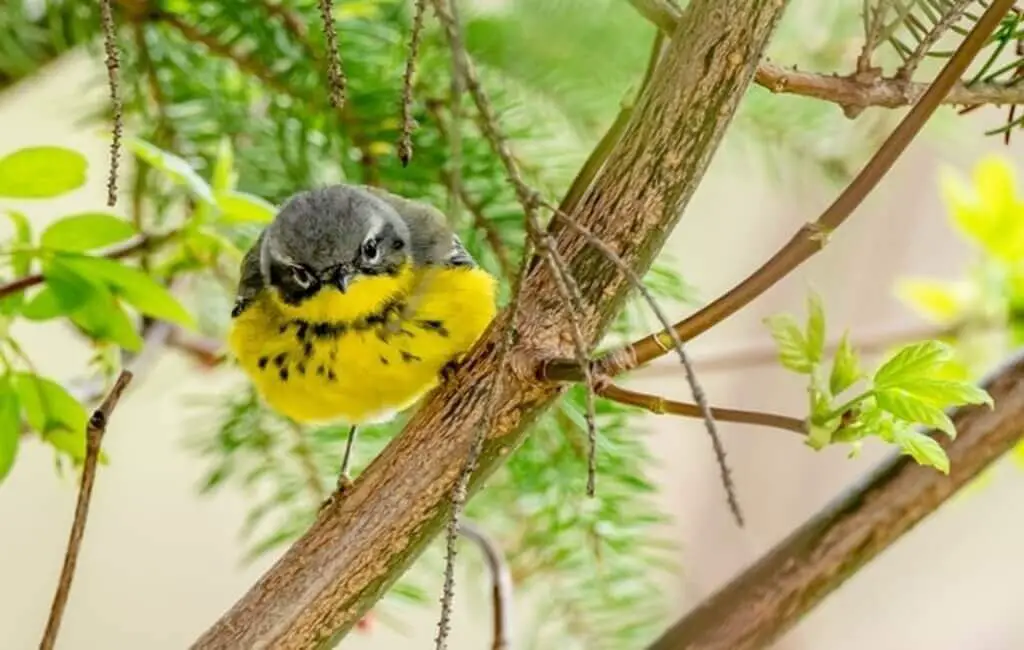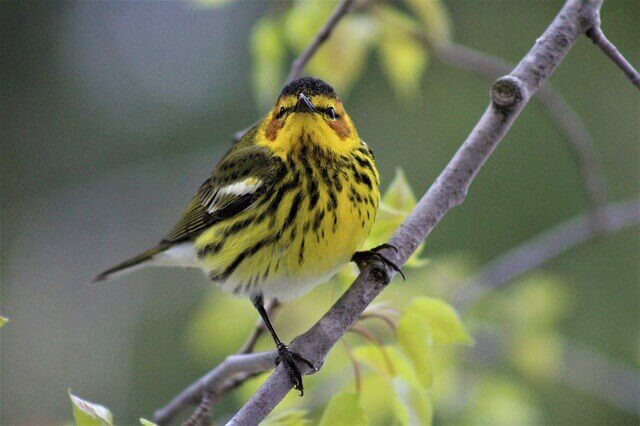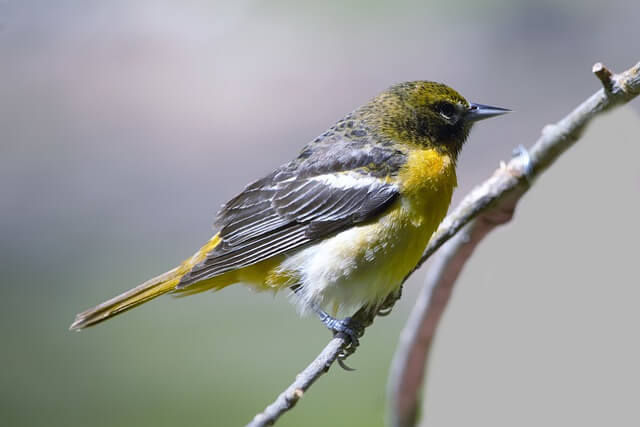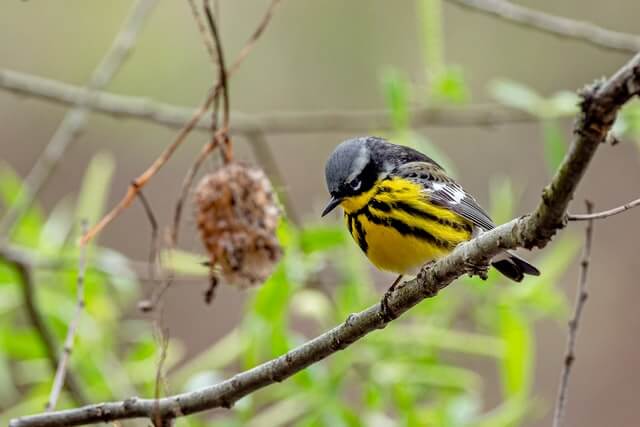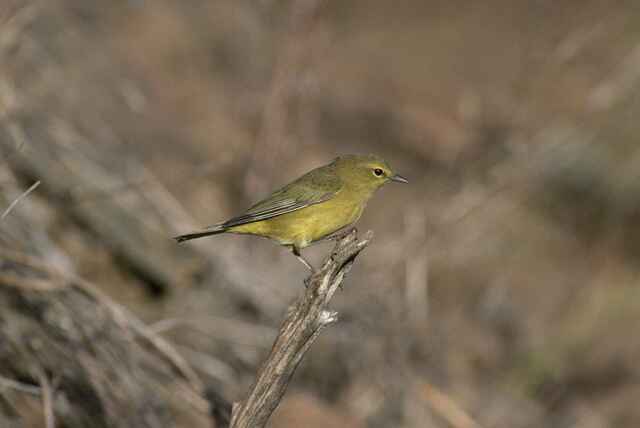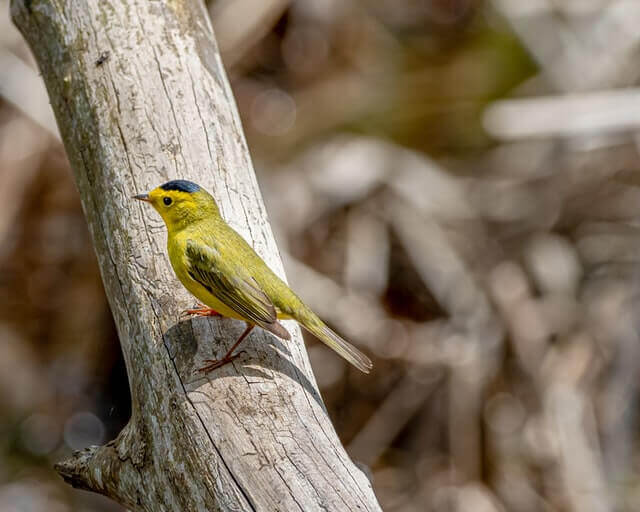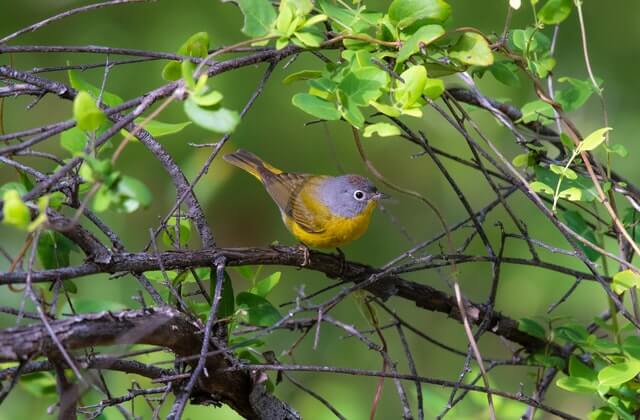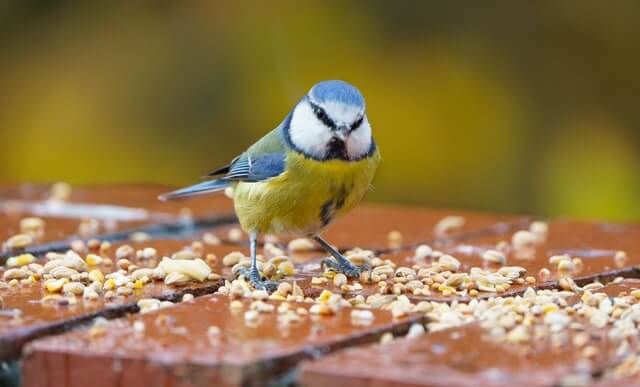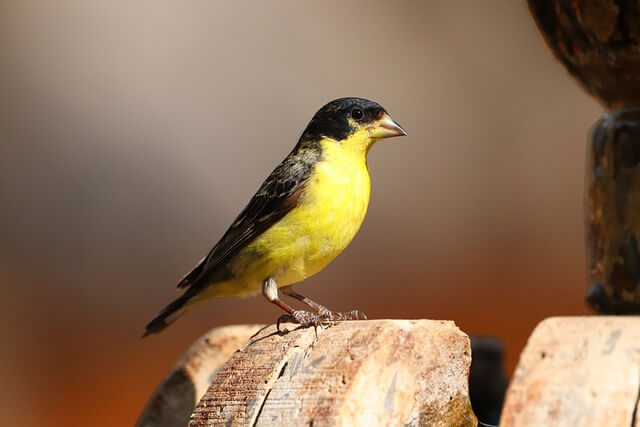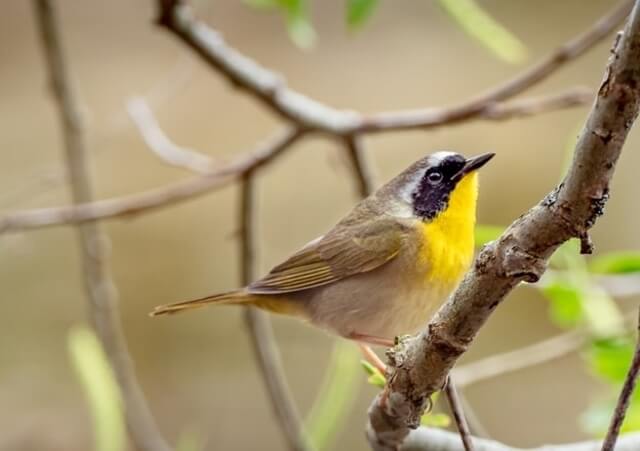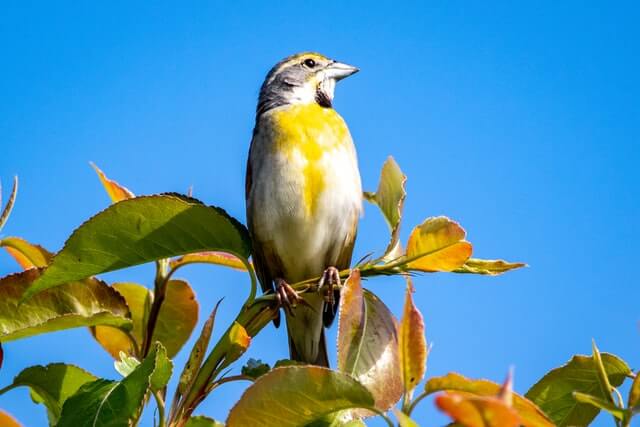Welcome to a world of avian wonders! In this captivating exploration, we delve into the realm of 14 small birds with yellow breasts. These feathered gems bring a burst of color to nature’s canvas. Join us on a visual journey as we uncover the unique beauty that these tiny birds offer to birdwatchers and nature enthusiasts alike.
Table of Contents
Small Birds With Yellow Breasts
Cape May Warbler
| Scientific Name | Length | Weight | Wingspan |
|---|---|---|---|
| Setophaga tigrina | 11-13 cm | 9-12 g | 20-23 cm |
The Cape May Warbler is a small songbird with a yellow breast that breeds in the northeastern United States and Canada. During the winter months, this species can be found in southern Central America and along the Gulf Coast south to northern South America. These birds migrate through Texas in the fall before continuing on their journey northwards into more familiar territory. They also occasionally visit Florida, Mexico, and Cuba.
Cape May Warblers primarily feed on insects and spiders during the summer months when they are raising their young. They are also known to eat tree sap from wounds made by sapsuckers. These birds can be found from Connecticut to Maine during the breeding season and along the Gulf Coast during the winter months.
Despite their relatively wide range, Cape May Warblers are considered a species of conservation concern due to habitat loss and fragmentation. Efforts are underway to protect and restore their breeding habitats in order to ensure their continued survival. These birds are a popular species among birdwatchers and are known for their distinctive appearance and behavior.
Northern Parula
| Scientific Name | Length | Weight | Wingspan |
|---|---|---|---|
| Setophaga americana | 11-13 cm | 6-9 g | 16-18 cm |
The Northern Parula is a small songbird that can be identified by its blue-gray upper parts and bright yellow breast feathers, which have beautiful blue patches on their wings. This species is found in the Eastern United States, as well as in southern Canada, Central America, and northern South America.
Northern Parulas are commonly found in dense deciduous forests with many understory shrubs, as well as at woodland edges where trees are growing close together or on moist ground near water sources such as streams or lakes. These birds primarily feed on berries, insects, spiders, fruits, and other small invertebrates.
Despite their relatively wide range, Northern Parulas are considered a species of conservation concern due to habitat loss and fragmentation. Efforts are underway to protect and restore their breeding habitats in order to ensure their continued survival. These birds are a popular species among birdwatchers and are known for their distinctive appearance and vocalizations.
Pine Warbler
| Scientific Name | Length | Weight | Wingspan |
|---|---|---|---|
| Setophaga pinus | 12-14 cm | 9-13 g | 20-23 cm |
The Pine Warbler is a small songbird that is commonly seen throughout the eastern United States. This species migrates from Canada to Mexico and is typically found in coniferous and mixed forests, particularly near water sources such as streams or wetlands. They are yellowish-green in color, with yellow throats and breasts.
Pine Warblers primarily feed on insects, nectar, fruit, and berries during migration season. However, when they are nesting, they will mainly consume caterpillars or insect larvae, which makes them an important predator of pests like gypsy moths. These birds are known for their sweet, trilling songs, which are often heard during the breeding season.
Despite their relatively wide range, Pine Warblers are considered a species of conservation concern due to habitat loss and fragmentation. Efforts are underway to protect and restore their breeding habitats in order to ensure their continued survival. These birds are a popular species among birdwatchers and are known for their distinctive appearance and behavior.
Magnolia Warbler
| Scientific Name | Length | Weight | Wingspan |
|---|---|---|---|
| Setophaga magnolia | 11-13 cm | 7-11 g | 20-23 cm |
The Magnolia Warbler is a migratory songbird that nests in Eastern North America. These small, black and white birds have an orange-yellow throat and breast, which adds a striking pop of color to their appearance. Each year, they arrive at the Atlantic coast and Gulf Coast of Florida from their wintering grounds in Central America, typically between March and May.
Many people who live near wetlands or other bodies of water enjoy spotting these brightly colored beauties when they return each spring. Magnolia Warblers primarily feed on insects but also eat berries from shrubs and trees such as magnolias. If you spot one of these birds this spring, try to remember where you saw it so you can watch for them again next year.
Despite their relatively wide range, Magnolia Warblers are considered a species of conservation concern due to habitat loss and fragmentation. Efforts are underway to protect and restore their breeding habitats in order to ensure their continued survival. These birds are a popular species among birdwatchers and are known for their striking appearance and vocalizations.
Blackburnian Warbler
| Scientific Name | Length | Weight | Wingspan |
|---|---|---|---|
| Setophaga fusca | 11-14 cm | 8-14 g | 20-23 cm |
The Blackburnian Warbler is a small songbird that belongs to the New World warbler family. The male has striking black and white plumage with an orange throat and breast, while the female has a yellow throat and breast. These birds are often found near deciduous forests, where they feed on insects, caterpillars, spiders, snails, slugs, and berries.
Blackburnian Warblers breed in Canada, ranging from Newfoundland to British Columbia and south to Pennsylvania, Colorado, Oregon, Washington state, and California. During the fall, they migrate along the Gulf Coast of the United States, and in the winter, they can be found as far south as Costa Rica, passing through Mexico and Central America.
Despite their wide range, Blackburnian Warblers are considered a species of conservation concern due to habitat loss and fragmentation. Efforts are underway to protect and restore their breeding habitats in order to ensure their continued survival. These birds are a popular species among birdwatchers and are known for their striking appearance and behavior.
Orange-crowned Warbler
| Scientific Name | Length | Weight | Wingspan |
|---|---|---|---|
| Oreothlypis celata | 11-13 cm | 7-11 g | 18-20 cm |
The Orange-crowned Warbler is a small bird with a subtle orange crown on its head. Its plumage varies in color from grayer to brighter yellow. This warbler can be found throughout North America, and it is often found near water sources such as creeks or streams. These birds like to fly close to the ground, searching for insects that are hiding in the grasses or under leaves.
Orange-crowned Warblers are typically found in dense foliage and bushes where they build their nests, although they can also be seen around clearings, near streams, or in woodlands. They prefer to nest close to the ground level to reduce the risk of predation while brooding. These birds primarily feed on insects and spiders, but they may also consume small fruits and berries.
Despite their relatively wide range, Orange-crowned Warblers are considered a species of conservation concern due to habitat loss and fragmentation. Efforts are underway to protect and restore their breeding habitats in order to ensure their continued survival. These birds are a popular species among birdwatchers and are known for their subtle appearance and behavior.
Wilson’s Warbler
| Scientific Name | Length | Weight | Wingspan |
|---|---|---|---|
| Cardellina pusilla | 10-12 cm | 5-9 g | 16-18 cm |
The Wilson’s Warbler is a small songbird with greenish-yellow plumage on its upperparts and yellow coloring on its underparts. The male has a distinctive black crown patch, which is visible in both winter and summer. These birds are known for their vocalizations, which include loud calls and songs that they use to defend their territory.
Wilson’s Warblers are primarily found in the eastern United States, ranging from Connecticut south to Florida and west to Missouri, Arkansas, Oklahoma, and Texas. They are also found in the Gulf Coast states of Louisiana, Mississippi, and Alabama. These birds feed mainly on insects and caterpillars, which they find by pecking through dead leaves, mosses, and lichens or by searching through tree branches.
Despite their relatively wide range, Wilson’s Warblers are considered a species of conservation concern due to habitat loss and fragmentation. Efforts are underway to protect and restore their breeding habitats in order to ensure their continued survival. These birds are a popular species among birdwatchers and are known for their distinctive appearance and vocalizations.
Blue-winged Warbler
| Scientific Name | Length | Weight | Wingspan |
|---|---|---|---|
| Vermivora cyanoptera | 11-13 cm | 7-11 g | 18-20 cm |
The Blue-winged Warbler is a small songbird that is found throughout North America. It has a distinctive appearance, with a bright yellow chest and dusky bluish-gray wings that feature white wing bars that are most visible when the bird is in flight. This species breeds in Canada and the United States, from Alaska to Maine and south to California, Texas, Missouri, and Illinois. During the winter, it can be found as far south as Panama and Argentina.
Blue-winged Warblers primarily feed on insects, caterpillars, spiders, and small seeds. They prefer forest habitats but can also be found in suburban areas with sufficient vegetation to support them. These birds are known for their sweet, buzzy songs, which are often heard during the breeding season.
Despite their relatively wide range, Blue-winged Warblers are considered a species of conservation concern due to habitat loss and fragmentation. Efforts are underway to protect and restore their breeding habitats in order to ensure their continued survival. These birds are a popular species among birdwatchers and are known for their distinctive appearance and vocalizations.
Nashville Warbler
The Nashville Warbler is a migratory songbird with an extensive range that includes the southern United States and northern Mexico. They are most commonly observed in North America during the summer months, from April through September. These small birds have a distinctive appearance, with a gray head, greenish-yellow back and wings, yellow throat and breast, and white belly.
Nashville Warblers typically inhabit thickets or brushy fields near streams, woodlands, or wetlands. They are active during the day and forage for food such as insects and caterpillars on trees and shrubs, occasionally visiting bird feeders.
Despite their wide range, Nashville Warblers are not often seen due to their preference for dense habitats. They are a popular species among birdwatchers and are known for their sweet, high-pitched songs. These birds are monogamous during breeding season and have an average lifespan of around 5 years.
Blue Tit
| Scientific Name | Length | Weight | Wingspan |
|---|---|---|---|
| Cyanistes caeruleus | 11.5 cm | 10-12 g | 17-20 cm |
The Blue Tit is a small bird that is primarily found in England, although there are populations throughout Europe. It is easily recognizable by its blue and yellow plumage, with a dark blue line across its eyes. These birds are known for their lively personalities and cheerful songs, which they use to communicate with other birds.
Blue Tits are adaptable creatures that can be found in a variety of habitats, including forests, woodlands, and gardens. They feed on insects and spiders, as well as seeds from plants. In fact, they are known to be frequent visitors to bird feeders in residential areas.
Despite their small size, Blue Tits are one of the most common songbirds in the UK, thanks to their ability to thrive in a variety of environments. Their adaptability and cheerful songs make them a popular species among birdwatchers and nature enthusiasts.
Lesser Goldfinch
| Scientific Name | Length | Weight | Wingspan |
|---|---|---|---|
| Spinus psaltria | 10-11 cm | 8-11 g | 20-22 cm |
The Lesser Goldfinch is a small bird that is commonly found in the eastern and central parts of North America. While they are fairly common in these areas, they are not as frequently observed on the west coast. Male Lesser Goldfinches have bright yellow underparts and black on the head, wings, and tail, while females are similar in appearance but with more olive tones on their upper parts.
These birds feed primarily on the seeds of grasses and weeds, which they gather in short flights from the ground or perches. They also eat insects, seeds, and berries, which they find while foraging on the ground or flying to catch from plants or trees.
Their nesting habits are dependent on their habitat, but they typically nest within a few feet of low-lying shrubs near water sources. Lesser Goldfinches are known for their acrobatic flight patterns and their cheerful, twittering songs. They are a popular species among birdwatchers and are often attracted to backyard bird feeders.
Common Yellowthroat
| Scientific Name | Length | Weight | Wingspan |
|---|---|---|---|
| Geothlypis trichas | 11-14 cm | 7-12 g | 16-23 cm |
The Common Yellowthroat is a small, insectivorous songbird that can be found throughout North America. The male is easily identifiable by its black mask and greenish-yellow back, wings, and tail, as well as its yellow throat and breast and white belly. Females lack the mask but are otherwise similar in appearance. During the winter, they migrate south, but they may return north if food sources are scarce.
This species has one of the highest population densities of any North American bird, and as a result, they have adapted to a wide variety of habitats, including forests, wetlands, farmlands, and urban areas. Common Yellowthroats primarily feed on insects such as flies, crickets, and caterpillars, as well as spiders, which they find on plants.
Their adaptability and insectivorous diet make them valuable contributors to pest control in many ecosystems. In addition, they are important indicators of wetland health, as they are often found in these habitats and their presence can indicate the presence of suitable breeding conditions. Common Yellowthroats are a popular species among birdwatchers and are known for their distinctive appearance and vocalizations.
Dickcissel
| Scientific Name | Length | Weight | Wingspan |
|---|---|---|---|
| Spiza americana | 13-16 cm | 23-33 g | 23-28 cm |
The Dickcissel is a common North American bird that can be found in the eastern and central United States. They prefer habitats such as marshy areas, prairies, and woodlands near streams. These birds are easily identifiable by their gray crowns and cheeks, brown upperparts with black streaks, black throats, and yellow breasts.
During the breeding season, Dickcissels are primarily found in fields or open habitats, but they can also be seen visiting gardens year-round. They forage on the ground and feed on a variety of foods, including seeds, insects, spiders, berries, and fruit. The Dickcissel’s call is a familiar sound of summer, often described as a buzzing “dick-dick-ciss-ciss”.
These birds are monogamous during the breeding season and have an average lifespan of around three years. They are a popular species among birdwatchers and are known for their distinctive appearance and vocalizations. Despite being a common sight in many areas, their populations have declined in recent years due to habitat loss and changes in agricultural practices.
Yellow Sapsucker
| Scientific Name | Length | Weight | Wingspan |
|---|---|---|---|
| Sphyrapicus varius | 19-22 cm | 30-56 g | 38-43 cm |
The Yellow-bellied Sapsucker is a common woodpecker that can be found in the eastern and northern parts of North America. They are often observed in forested areas and are easily recognizable by their distinctive appearance, with barred black-and-white plumage, a red cap, and (in males) a red throat. As their name suggests, they have yellowish underparts, including the breast area, which is tinged with yellow transitioning to a whiter color in the lower region.
Yellow-bellied Sapsuckers primarily feed on sap from trees, but they also consume insects and fruit. They have a unique brush-tipped tongue that helps them lap up sap and insects. These birds are monogamous during the breeding season and have an average lifespan of around four years.
Despite their common name, Yellow-bellied Sapsuckers are not actually true “sapsuckers” – they do not create the neat rows of holes in trees that are commonly associated with the term. Instead, they drill small, irregular holes in trees to extract sap and insects. These birds are a popular species among birdwatchers and are known for their unique appearance and feeding habits.
Conclusion
As we conclude our journey through the vibrant world of small birds with yellow breasts, we hope you’ve been as captivated by their beauty as we have. These avian wonders remind us of the incredible diversity found in nature, even within the smallest of creatures.
Whether you’re an avid birdwatcher or simply appreciate the beauty of the natural world, these tiny birds bring a burst of sunshine to our surroundings. Remember to keep your binoculars and cameras ready, as you never know when you might catch a glimpse of these charming birds in your own backyard. Happy birdwatching!

